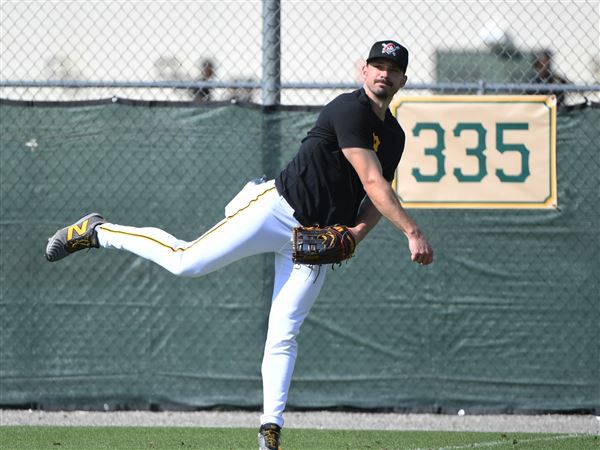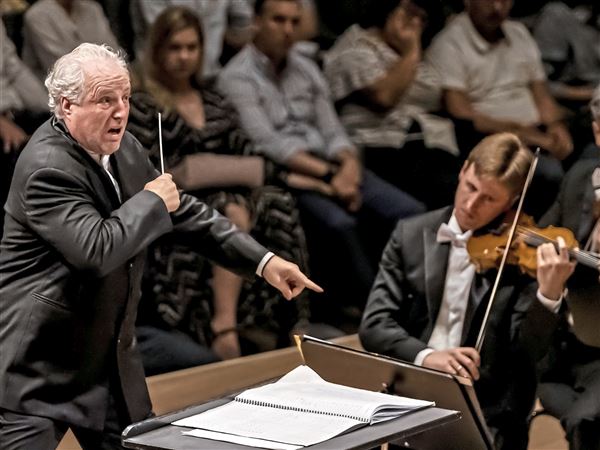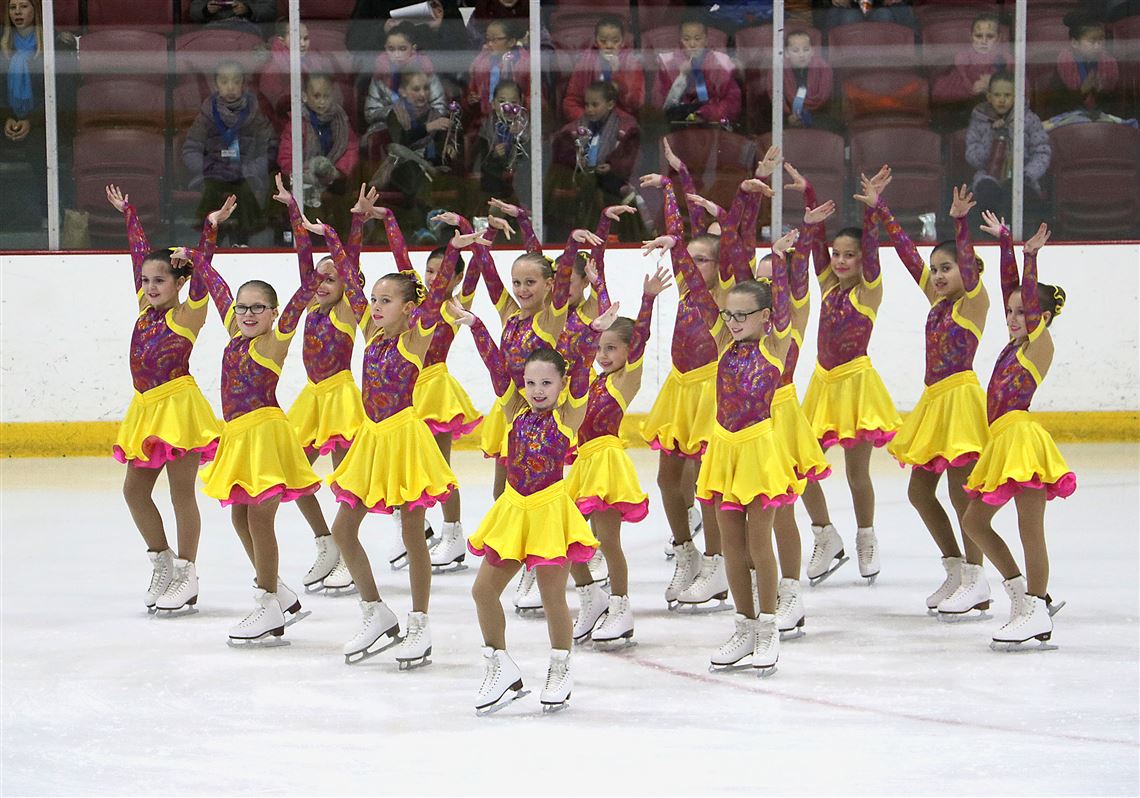Annie Volk, a recent Quaker Valley High School grad, knew she wanted to pursue synchronized skating in college since she was a kid.
Already a skater with the Steel City Blades at the Robert Morris University Island Sports Center, Miss Volk was at a competition in 2013 at Lake Placid N.Y. when she was fascinated by the level of competition at the college level.
She recalled thinking: “Man, I want to do that.’’
Now she will take her fancy footwork and dedication to teamwork to the University of Delaware and its synchronized ice skating team.
Synchronized skating is a discipline of figure skating where 8 to 20 skaters skate together as one. The team moves at a high rate of speed while doing difficult footwork and precise formations. And skaters do it on steel blades about 3/16 of an inch thick that are slightly shorter than a figure skater’s.
It’s much more than the Rockettes on ice; it’s art and athleticism.
But since this team sport takes the same years of learning, practice and expense as it does to become a figure skater alone in the spotlight — why share the rink?
“It’s nerve wracking to go out in front of a panel of judges; being with friends makes it easier,’’ Miss Volk explained. “And, it’s great to be around people who love doing what you do.”
The RMU sports complex in Neville Island has one of the few synchronized skating programs, called the Steel City Blades, in the region. The Blades were formed in 2004.
“When you see [skaters] on TV and then you see them live, they’re much more dynamic and fast,’’ said the center’s skating director Beth Sutton. “It’s pretty impressive.’’

Steel City Blades B1-preliminary skaters from 2016 season coached by Cari Breed at Robert Morris University Island Sports Center. Jessica Phillips
A team of skaters moving as one even more so.
The 47-year-old skater toured with Ice Capades in the 1990s, which she called more of a “showgirl type skating.”
But synchronized skating, often called synchro, isn’t only about entertaining, Ms. Sutton noted. It’s the fastest growing form of ice skating in the United States. The sport, originally called precision skating, dates back to the late 1950s and the formation of the Hockettes, skaters who entertained during intermissions of the University of Michigan Wolverine’s hockey games.
Today there are about 600 synchronized skating teams registered with the U.S. Figure Skating Association. Most are all-female, but there are a few men’s groups, as well as co-ed teams.
Ms. Sutton said that while each year the demands get more difficult, the sport “is a family thing, too. Everybody packs up and goes to competitions.’’
“It’s very much a community,” agreed another Blades’ coach, Jennie Vicinie.
“We have an amazing group of skaters and I love watching them learn, grow and bond as a team,” she said. “They develop a support system for their individual endeavors.”
Each individual on the team must meet guidelines set by both the Blades and the U.S. figure skating organization. And each skater is required to take individual lessons and pass U.S. figure skating tests.
Much like dancers, synchronized skaters perform routines called programs and each requires six elements: block, circle, line, intersection, wheel and creative element.
“The creative element has changed a lot since we started coaching,” said Blades’ juvenile team coach and Annie’s mother Karen Volk who once performed with Disney on Ice. Now, she said, programs must have a theme that ties each element together.
The art and athleticism is apparent at a recent rehearsal. Each skater’s moves are precise, with sharp turns and spins. As a flowing unit, the girls overlap arms or hold hands as they weave through lines or rotate in circles. Higher-level teams even incorporate lifts.
As the elements are performed and a soundtrack provides a theme, “everything comes together like a wedding,” Ms. Volk said.
The coaches emphasized that strong skating fundamentals are essential. If skaters do not have good basic techniques, they’ll never be a good synchronized skaters,’’ Ms. Volk said.
Not including dance lessons and private skating lessons, the Blades’ higher-level teams (there are several age categories) practice on- and off-ice, two days per week for three to four hours each, as well as some early-morning Saturday sessions.
“Ice time is expensive.’’ Ms. Vicinie said.
In fact the the sport itself is expensive. Private lessons range from $17 to $36 for a half hour and costs increase as a skater progresses. Depending on the team level, and in addition to skaters’ individual lessons, ice time and coaching team fees range from $1,000 to $2,500 per season. Then there are additional fees for travel and those glamorous costumes.
A parent organization hosts a variety of fundraisers to help out.
“Families here are very dedicated,’’ Ms. Vicinie said.
Synchronized skating is has become highly competitive at the collegiate level and something more and more skaters aspire to.
“I went to Miami University of Ohio, which is one of the most highly respected organizations, and it has incorporated more skills like jumps, spins, turns and things that were not in when I was in college,” Ms. Volk said.
Following in her mother’s footsteps, Miss Volk remembered what made her want to take her skating to a new level.
While attending the Eastern Sectional Championships in 2013 , she said she became dazzled by the University of Delaware team’s performance and that school’s history of wins.
At some colleges, synchronized skating is a varsity sport and scholarships are available. Miami University in Ohio and Adrian College in Michigan are two. Others such as Delaware have club level teams.
Dedicated Steel City Blade synchro skaters have earned spots on teams at Ohio University, Michigan State, University of Vermont, Western Michigan University, University of Notre Dame, University of Illinois and Adrian.
“Some teams are more intense than the others, but it’s a nice break from other college studies,” Ms. Sutton said. “To simply be able to do what you love is the best.’’
“We hope [skaters] gain all the friendships and everything that comes with being part of a highly competitive team,” Ms. Volk said. “But then we hope to prepare them to skate in college — if they decide to.”
Details: www.steelcityblades.org. Skating lessons in a variety of disciplines are available at RMU; visit rmuislandsports.org.
Fitale Wari: fwari@post-gazette.com 412-263-1130.
First Published: July 13, 2017, 4:41 p.m.

















